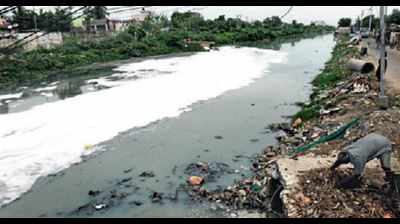- News
- City News
- chennai News
- Sewage, effluents pollute Buckingham Canal
Trending
This story is from September 1, 2017
Sewage, effluents pollute Buckingham Canal

The plant at Perungudi collects raw sewage that it puts through primary and secondary treatment before releasing it into the canal.
CHENNAI: Buckingham Canal near Neelankarai now resembles a bubble bath. The waterway along East Coast Road (ECR) is carrying a white foam-like substance, which is being released by Metrowater's Perungudi sewage treatment plant (STP).
When contacted, Metrowater officials said a sample of the frothy liquid will be sent for a lab test to study its impact on the water body.
The STP treats raw sewage collected from southern parts of the city.The sewage undergoes primary and secondary treatment at the STP before it is released into the canal. The canal drains into the ocean through the Muttukadu lake along ECR. On the Neelankarai Link Road, which bridges ECR and OMR, the treated sewage released from the STP enters the Buckingham Canal. Locals said they have been witnessing the white frothy discharge for at least the last few years.
A storm water drain channel also drains into the canal on Neelankarai Link Road. However the discharge from the drain channel is not frothy but foul-smelling. The channel carries raw sewage, thanks to illegal sewer lines connected to the channel by residents and commercial establishments. Several inlets along the OMR release sewage into the canal.
The STP has two treatment units that have a combined capacity to treat 150 million litres of sewage per day. An audit conducted by citizen group Arappor Iyakkam in May found that Metrowater's five STPs were operating below standard levels.The audit concluded that there were not enough monitoring mechanisms to ensure compliance of standards.
Measurement devices, such as flow meters for measuring the quantum of raw sewage and treated sewage, were found to be in poor condition. The primary clarifier, secondary clarifier, bio gas engine and other components of the treatment plants were proved to be dysfunctional in many cases. The audit also found that sewage was not treated to standard levels before being let into water bodies for discharge into the ocean.
When contacted, Metrowater officials said a sample of the frothy liquid will be sent for a lab test to study its impact on the water body.
The STP treats raw sewage collected from southern parts of the city.The sewage undergoes primary and secondary treatment at the STP before it is released into the canal. The canal drains into the ocean through the Muttukadu lake along ECR. On the Neelankarai Link Road, which bridges ECR and OMR, the treated sewage released from the STP enters the Buckingham Canal. Locals said they have been witnessing the white frothy discharge for at least the last few years.
A storm water drain channel also drains into the canal on Neelankarai Link Road. However the discharge from the drain channel is not frothy but foul-smelling. The channel carries raw sewage, thanks to illegal sewer lines connected to the channel by residents and commercial establishments. Several inlets along the OMR release sewage into the canal.
Officials said foaming in treated sewage is not uncommon and could occur due to several reasons. Frothing could be a result of the waste water containing surfactants which take a long time to degrade. It could also be due to the presence of excessive nitrogen or methane. As Perungudi residents do not have sewerage facility, Metrowater engineers are only tasked with looking after water supply .
The STP has two treatment units that have a combined capacity to treat 150 million litres of sewage per day. An audit conducted by citizen group Arappor Iyakkam in May found that Metrowater's five STPs were operating below standard levels.The audit concluded that there were not enough monitoring mechanisms to ensure compliance of standards.
Measurement devices, such as flow meters for measuring the quantum of raw sewage and treated sewage, were found to be in poor condition. The primary clarifier, secondary clarifier, bio gas engine and other components of the treatment plants were proved to be dysfunctional in many cases. The audit also found that sewage was not treated to standard levels before being let into water bodies for discharge into the ocean.
End of Article
FOLLOW US ON SOCIAL MEDIA










